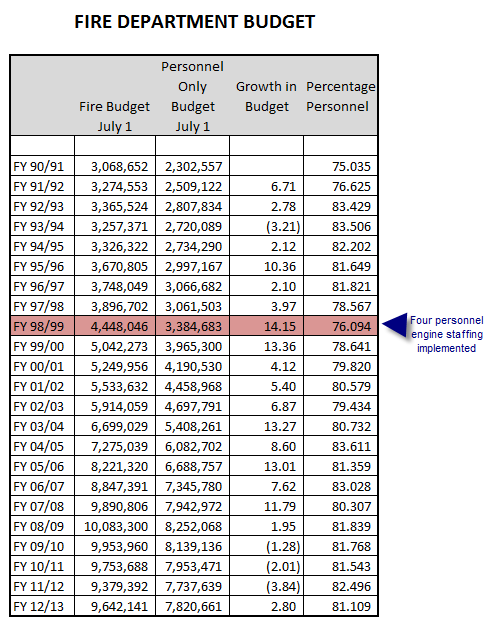 On Tuesday, the Vanguard responded to a letter to the editor that argued against former Interim Chief Scott Kenley’s recommendation to reduce the on-duty fire personnel from 12 to 11.
On Tuesday, the Vanguard responded to a letter to the editor that argued against former Interim Chief Scott Kenley’s recommendation to reduce the on-duty fire personnel from 12 to 11.
In response to that article, one poster, likely a former firefighter argued, “Read it here on your blog, firefighters give back money over a 3 year period, adding up to $850,000.00 dollars, I see no mention of this in your blog today, all I see is your usual Vendetta talking of the firefighters.”
All of this bolstering the idea that, “They did make the sacrifice.”
But there are also sorts of problems with these claims.
The first problem is that the “giveback,” if you will, occurred for the 2009 MOU (memorandum of understanding). That was four years ago. And it is not as though the firefighters uniquely gave money back to the city – every bargaining unit did so.
However, unlike every other bargaining unit EXCEPT DCEA (Davis City Employees Association), the firefighters have not come to agreement for this year’s MOU. That means they have not taken pension concessions, they have not taken retiree health concessions, and they have not taken a reduction in the cafeteria cash-out that everyone else in the city has taken.
The firefighters are the highest compensated of the city’s rank and file employees and they make more than $1000 more per month than their police counterparts. During the last decade, their salaries alone almost doubled, and that does not include the expansion of the fire department to accommodate four on an engine and it does not include the enhanced 3% at 50 benefits.
We argued that if the firefighters want to avoid personnel reductions, they have a choice; they can take a reduction in salary. The former firefighter argues that they have already given back $850,000 over three years. Well, that was four years ago, the money was insufficient, and, as we will show you, the $850,000 is a gross distortion.
In fact, I do not even know where the $850,000 figure comes from. Back in January 2010, when the MOU was passed, the council majority argued that it represented a $744,000 savings.
The figure was distorted by the council majority at the time, because what they did was take the last year of pay increases in the previous MOU, projected it into the future and derived the savings not from the actual 2008-09 budget, but from that projected number.
When you calculate the savings based on the baseline, it only came to about $244,000 over the three-year MOU, or about $80,000 a year.
The retired firefighter later added, “The giveback was $850,000.00, and your City of Davis Fire Dept. is down ( 9 ) personnel currently.”
I am not sure how you come to that, either.
Here is the fire department budget:

As you can see, in 2008-09, personnel costs amounted to $8.25 million. That number dropped over the next three years. Over the next four years, the city saved $1.36 million over the peak year of 2008-09
But here is the problem, the firefighter wants to argue that they gave back $850,000 over three years AND that they are down nine firefighters overall.
The $850,000 leaves only about $510,000 in savings over four years. Even at one year, nine firefighters at $150,000 average total compensation pushes you well over $1 million for a single year. Even understanding that some of that money is offset by overtime to backfill, the numbers just do not add up to support the claims.
Now Ms. Wendy Benner, the author of the letter, argues, “Currently, with four people arriving in one engine, two could go inside and two would remain outside, ensuring that a home is vacant and fighting the fire from the inside out. However, with three people on a single engine, no one could enter the burning structure until a second truck arrived from another station. Therefore, firefighting begins on the outside, pushing the fire inwards, where all our memories, belongings and, most importantly, loved ones could be trapped. Not BMWs, Mr. Rifkin, people.”
However, a former student firefighter from UC Davis, who is presently a firefighter in another jurisdiction, disputes this claim.
He writes, “‘2 in 2 out’ does NOT apply when a CONFIRMED victim is inside a structure fire. No firefighter would EVER sit outside knowing there’s a life in jeopardy. ‘2 in 2 out’ DOES apply without a victim though.”
“When firefighters show up to a house fire we do not just run in with hoses flowing. Without a known rescue, there is usually a 2-5 minute set up time. During this period we are generally pulling hoses to the point of entry, preparing tools to force entry, setting up ladders, connecting to a fire hydrant, and putting on our SCBA (air tank) while the company officer sizes up the scene and walks around the building looking for secondary exits, room of origin, and safety concerns,” he writes.
“Only once most of these tasks are completed does the team enter the structure. Even a known rescue does not speed this process much because at the end of the day we need to account for our safety and go home safe,” he continues.
He argues, in fact, that the four-person argument “is largely a herring,” because “by the time the above tasks are completed it is reasonable to expect a second engine or truck company will have arrived thus nullifying ‘2 in 2 out’ before the first due engine was ready to go in anyway.”
He adds, “Refer to the Citygate report to see which areas of the city have a second company arrival within 4 minutes of the first. That’s most of the city and UCD.”
This gibes with the letter sent from a 33-year firefighter with the city of Davis.
As we previously noted, in his email to the city council and staff, he wrote, “It is widely accepted that the City of Davis Fire Department was the only department in the State of California to implement four person engine companies based solely on the OSHA ‘Two In Two Out’ regulation.”
In other words, most other jurisdictions in the state have been able to maintain safety levels using three-person engines.
The firefighters have engaged the public in a deceptive game, trying to stir up fears. But most of these fears are unfounded.
—David M. Greenwald reporting






Unless it was a virtual suicide effort, any and all first-responders would go into a hazardous building with people in peril. Even if policy dictated one to wait, that policy would be deliberately ignored.
I know that representations are being made here to support or refute an economic circumstance. But police, fire, and even contract para-medics freely put themselves in peril to save the lives of others. I’ve never seen an instance where a first-responder not performed in a heroic circumstance when it involved rescue of persons, or pets for that matter. So, why don’t we just toss that story aside because it is not true and insults all public safety personnel to the core.
this article looks a lot like checkmate. the firefighters were never going to win on the budget argument, but having avatar spout off on the $850,000 was never going to end well. but having two firefighters step forth to show that having three on an engine wasn’t going to slow the response is the death knell for their argument. and it makes sense, after all, most departments have three, so you are telling me that they people sitting on their rears waiting for the second unit to arrive?
I should have said “Red Herring.” I also agree with Mr Coleman. If there is a viable life to be saved we all will move heaven and earth to do so regulations be damned if need be.
[quote]Unless it was a virtual suicide effort, any and all first-responders would go into a hazardous building with people in peril. [/quote]While not disagreeing with Phil, I’d like to note that I believe that many, if not most of us, have or will do the same thing. I think most are “hard-wired” to do that, as humans.
The difference is that FF’s, Police, EMT’s are better trained, when following their human instincts, to have a better outcome [for those in peril, and for themselves].
it appears that the firefighters are not willing to defend their positions on a forum where they would be on equal footing.
Phil wrote:
> any and all first-responders would go into
> a hazardous building with people in peril.
> Even if policy dictated one to wait, that
> policy would be deliberately ignored.
In Alameda CA in 2011 they did not ignore the “policy” (see below from ABC News):
“Alameda police and firefighters stood by and watched as a man drowned off Crown Beach in Alameda on Monday. Authorities are now trying to explain why they had no choice but to stand on the shoreline.
The Alameda Fire Department says budget constraints are preventing it from recertifying its firefighters in land-based water rescues. Without it, the city would be open to liability.
“Well, if I was off duty I would know what I would do, but I think you’re asking me my on-duty response and I would have to stay within our policies and procedures because that’s what’s required by our department to do,” Alameda Fire Div. Chief Ricci Zombeck said when asked by ABC7 if he would enter the water to save a drowning child.”
“if he would enter the water to save a drowning child.”
This was a “bait and switch” question. Circumstances do matter. Phil Coleman wrote ” unless it was a virtual suicide effort” policy would be deliberately ignored. In the Alameda incident, it was a suicide effort by an adult. This is a very different situation from an accidental drowning of a child. How far do we expect our first responders to go , policy or no policy ? Do we expect them to put their own lives at risk to stop an obvious suicide attempt under extremely perilous circumstances. I don’t know the answer, but do feel it is important to frame the question accurately.